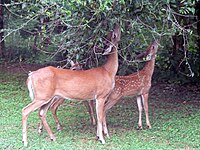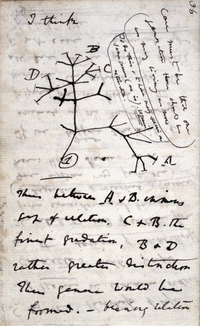
Effects of large‐scale disturbance on animal space use: Functional responses by greater sage‐grouse after megafire
Sign Up to like & getrecommendations! Published in 2023 at "Ecology and Evolution"
DOI: 10.1002/ece3.9933
Abstract: Abstract Global change has altered the nature of disturbance regimes, and megafire events are increasingly common. Megafires result in immediate changes to habitat available to terrestrial wildlife over broad landscapes, yet we know surprisingly little… read more here.
Keywords: greater sage; space use; functional responses; megafire ... See more keywords

FoRAGE database: A compilation of functional responses for consumers and parasitoids.
Sign Up to like & getrecommendations! Published in 2022 at "Ecology"
DOI: 10.1002/ecy.3706
Abstract: Functional responses - the relationships between consumer foraging rate and resource (prey) density - provide key insights into consumer-resource interactions while also being a major driver of population dynamics and food web structure. We present… read more here.
Keywords: database; consumer resource; functional responses; forage database ... See more keywords

Optimal prey switching: Predator foraging costs provide a mechanism for functional responses in multi-prey systems.
Sign Up to like & getrecommendations! Published in 2022 at "Ecology"
DOI: 10.1002/ecy.3928
Abstract: Foragers must balance the costs and gains inherent in the pursuit of their next meal. Classical functional responses formulations describe consumption rates driven by prey density and are naive to predator foraging costs. Here, we… read more here.
Keywords: functional responses; predator; foraging costs; predator foraging ... See more keywords

Warming and predator drive functional responses of three subtropical cladocerans
Sign Up to like & getrecommendations! Published in 2021 at "Aquatic Ecology"
DOI: 10.1007/s10452-021-09870-5
Abstract: Climate warming can change species performance and ecological interactions, which alter the energy flow in aquatic ecosystems. Here, we set microcosms to analyse how warming and predator affect the functional responses of three subtropical cladocerans… read more here.
Keywords: predator; responses three; secondary productivity; warming predator ... See more keywords

Predatory impacts of alien decapod Crustacea are predicted by functional responses and explained by differences in metabolic rate
Sign Up to like & getrecommendations! Published in 2018 at "Biological Invasions"
DOI: 10.1007/s10530-018-1735-y
Abstract: Alien predators can have large impacts on prey. It is important that we understand, and ideally predict, these impacts. Here, we compare predatory impacts of size-matched decapod crustaceans—invasive alien Eriocheir sinensis and Pacifastacus leniusculus, and… read more here.
Keywords: sinensis; decapod; metabolic rate; predatory impacts ... See more keywords

Pushing the switch: functional responses and prey switching by invasive lionfish may mediate their ecological impact
Sign Up to like & getrecommendations! Published in 2021 at "Biological Invasions"
DOI: 10.1007/s10530-021-02487-7
Abstract: Biodiversity is declining on a global scale and the spread of invasive alien species (IAS) is a major driver, particularly through predatory impacts. Thus, effective means of assessing and predicting the consequences of IAS predation… read more here.
Keywords: prey; functional response; responses prey; prey switching ... See more keywords

Bistability and Hopf bifurcation of a tritrophic system with Holling functional responses
Sign Up to like & getrecommendations! Published in 2021 at "Heliyon"
DOI: 10.1016/j.heliyon.2021.e06212
Abstract: In this paper we analyze the dynamics of a tritrophic food chain, with functional responses of Holling type III and II for the mesopredator and superpredator respectively and logistic growth rate for the prey. We… read more here.
Keywords: bistability hopf; bifurcation tritrophic; system; hopf bifurcation ... See more keywords

Purkinje cells located in the adult zebrafish valvula cerebelli exhibit variable functional responses
Sign Up to like & getrecommendations! Published in 2021 at "Scientific Reports"
DOI: 10.1038/s41598-021-98035-3
Abstract: Purkinje cells are critically involved in processing the cerebellar functions by shaping and coordinating commands that they receive. Here, we demonstrate experimentally that in the adult zebrafish valvular part of the cerebellum, the Purkinje cells… read more here.
Keywords: adult zebrafish; located adult; cells located; functional responses ... See more keywords

Theoretical investigation of functional responses of bio-molecular assembly networks.
Sign Up to like & getrecommendations! Published in 2023 at "Soft matter"
DOI: 10.1039/d2sm01530g
Abstract: Cooperative protein-protein and protein-DNA interactions form programmable complex assemblies, often performing non-linear gene regulatory operations involved in signal transductions and cell fate determination. The apparent structure of those complex assemblies is very similar, but their… read more here.
Keywords: topology; network; functional responses; theoretical investigation ... See more keywords

Differential effects of climate warming on reproduction and functional responses on insects in the fourth trophic level
Sign Up to like & getrecommendations! Published in 2019 at "Functional Ecology"
DOI: 10.1111/1365-2435.13277
Abstract: Abstract Understanding the effects of anthropogenic global warming (AGW) on species interactions is essential for predicting community responses to climate change. However, while effects of AGW on resource?consumer interactions at the first and second trophic… read more here.
Keywords: trophic level; insects; level; fourth trophic ... See more keywords

Functional responses in animal movement explain spatial heterogeneity in animal–habitat relationships
Sign Up to like & getrecommendations! Published in 2017 at "Journal of Animal Ecology"
DOI: 10.1111/1365-2656.12682
Abstract: Understanding why heterogeneity exists in animal-habitat spatial relationships is critical for identifying the drivers of animal distributions. Functional responses in habitat selection - whereby animals adjust their habitat selection depending on habitat availability - are… read more here.
Keywords: movement; heterogeneity; selection; animal habitat ... See more keywords